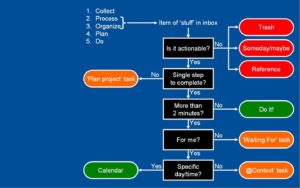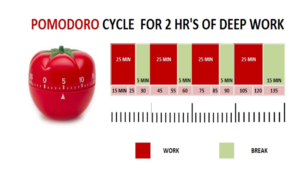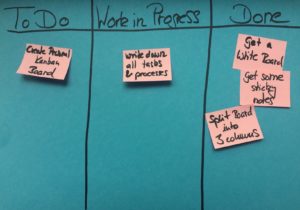Before I get to describing the Good Change Done system (GCD) that this website is all about, let’s look at some of the most famous productivity systems out there. Tops on that list is probably Getting Things Done (GTD). It is by far the most famous, so we’ll look at that and a few others and compare them.
 1. Getting Things Done (GTD) is a great system invented by David Allen, it’s all about collecting stuff and putting it through a process grinder or workflow. The method is about managing and perfecting this workflow, it’s seen as a chain, where your productivity is tied to the weakest link in this chain. Here are the steps to the workflow:
1. Getting Things Done (GTD) is a great system invented by David Allen, it’s all about collecting stuff and putting it through a process grinder or workflow. The method is about managing and perfecting this workflow, it’s seen as a chain, where your productivity is tied to the weakest link in this chain. Here are the steps to the workflow:
Collect -> Process -> Organize -> Review -> Do
In GTD each of these steps in the flow broken down into a discipline with inputs, outputs, decision gates, tools and actions. Each step is designed to push the stuff you want to get done down the chain. If the thing is simple enough, you do it right away, if not then it churns through the grinder to find its place in the right context, on your calendar, part of a project, or your daily/weekly chores.
GTD is all encompassing, as the process is supposed to be applied 6 areas of focus, they are:
- Current actions
- Current projects
- Areas of responsibility
- 1 to 2 year goals
- 3 to 5 year goals
- Life goals
I like the system, it can put you in control of your entire life. But it can get a bit much managing the system. I feel like it’s easy to get lost putting too much energy implementing the system.
 2. Don’t Break the Chain is a system inspired by Jerry Seinfeld, so some may know it as the Seinfeld System. It’s all about creating good habits through gamification. That’s right, you turn it into a game to see if you can keep up the good behavior for as long as possible or until you have mastered it or completed the thing you set out to do.
2. Don’t Break the Chain is a system inspired by Jerry Seinfeld, so some may know it as the Seinfeld System. It’s all about creating good habits through gamification. That’s right, you turn it into a game to see if you can keep up the good behavior for as long as possible or until you have mastered it or completed the thing you set out to do.
The way it works is you pick a day to start doing the thing you want to develop, by doing it and marking your calendar with an X. Then you do it again the next day, and you market your calendar with an X. You keep doing this, and the challenge is to to break the chain of Xs until you have accomplished your goal.
- Get a calendar
- Decide what you want to accomplish daily
- Mark the calendar with an X each day you do it
It’s really that simple. But to be practical you should put a little more structure into figuring out how your going to manage all the things you want to do, so here’s a guideline:
- Start with a few things you want to accomplish, develop some habit, accomplish some task, achieve some goal, whatever. Make it the three most important things to do that you tend to procrastinate over.
- Next you need to define exactly what it is you need to do of that thing on a daily basis to consider that day worthy of an X, and to keep the chain going.
- Plan for the way life works. It may not be practical to do something 7 days a week, so come up with well defined break days, and then mark your calendar appropriately on off days.
- Make sure your calendar is somewhere where you can’t avoid it, perhaps on the wall right in front of your desk.
- Put a big red X each day you are successful.
Don’t break the chain is excellent for developing habits, as studies show most habits can be ingrained through repetition over at least two week of doing. It can also help with your procrastination problem. It’s a simple system and anyone can do it. However as a personal productivity system it may not help you with organizing your day, or handling unexpected things.
 3. The Pomodoro Technique is a fixed time box method, developed by Francesco Cirillo, a productivity guru (there’s a book by the creator). The idea is to create a natural tempo for yourself so that you stay focused. Cirillo determined that 25 minutes was the optimal time for most people to keep focus. He called these Pomodoros. The techniques calls for a 5 minute break between Pomodoros, and after 4 Pomodoros you take a longer break, maybe go to lunch or quit for the day knowing you got something done using peak focus.
3. The Pomodoro Technique is a fixed time box method, developed by Francesco Cirillo, a productivity guru (there’s a book by the creator). The idea is to create a natural tempo for yourself so that you stay focused. Cirillo determined that 25 minutes was the optimal time for most people to keep focus. He called these Pomodoros. The techniques calls for a 5 minute break between Pomodoros, and after 4 Pomodoros you take a longer break, maybe go to lunch or quit for the day knowing you got something done using peak focus.
You will want to get a timer to stick to this schedule. Either your smart phone or a mechanical timer will work. Some people use a timer that looks like a tomato, as Pomodoro is actually a tomato sauce in the culinary world, and the fans of the system all must have their tomato timer!
Here are the objectives in achieving peak Pomodoro:
- Divide your goal up into Pomodoros, figure out how many you’ll need to do.
- Clear any and all distractions from interrupting your Pomodoro
- Structure each Pomodoro into a 3 step mini project a) Plan, b) Work, c) Review.
- Plan your Pomodoros so that they fit into your natural workflow
The pluses of this system is that time is a great regulator, you start developing a natural rhythm that helps you stay focused and avoid getting burnt out. The techniques makes it easy to manage your day and avoid distractions. This is an awesome method for someone that has a big project to do, perhaps not so good for someone that manages a lot of projects or a job that has constant changing demands or requires that you multitask — although I don’t personally believe multi-tasking is a good thing or even possible, no hate mail please.
 4. Zen to Done (ZTD) is a system most similar to my system, Good Change Done. In fact I was inspired to create this website in part by ZTD and the inspirational work done by its creator Leo Babauta. ZTD is like the antithesis to GTD, in that it puts all the focus on developing habits over a structured process. Babauta doesn’t discount the process, in fact he says you should adopt any or all of the GTD process, but in order to stay flexible, or to fit your personality. There’s no need.
4. Zen to Done (ZTD) is a system most similar to my system, Good Change Done. In fact I was inspired to create this website in part by ZTD and the inspirational work done by its creator Leo Babauta. ZTD is like the antithesis to GTD, in that it puts all the focus on developing habits over a structured process. Babauta doesn’t discount the process, in fact he says you should adopt any or all of the GTD process, but in order to stay flexible, or to fit your personality. There’s no need.
In fact, Babauta has 10 habits that he says are key to develop, but even here he says it’s not essential to develop all of them, just concentrate on the ones that work best with your personality and get the things done you need done and make you happy.
The big take-away with ZTD is that it focuses on the habits and doing rather than a system. Babauta believes that if you perfect habits and ficus on getting something done and done right before moving onto the next thing, then you will become more productive and more satisfied and ultimately you will become happier.
ZTD is a Top-Down approach, where GTD is a Bottom-Up approach. In other words ZTD focuses on the essential most important things, and focusing on doing those things first until complete. In. Contrast, GTD takes on everything that comes along and processes it.
Here’s how ZTD works, it’s a set of habits that are loosely ordered in a kind of process, and while it’s not required that you master all of the habits, or do them in any particular order, it is recommended that you try to master a few, concentrating on the lower numbered ones first.
- Collect Habit – tasks, ideas, projects and record or journal them.
- Process Habit – each day clear your inbox/desk, attend to things that can be done now
- Plan Habit – identify the 3 most important things to do for the day, week and year
- Do Habit – sit down and do a task without distraction until complete
- Journal Habit – keep simple lists, update frequently, simplify when needed
- Organize Habit – Have a place for everything, keep it up to date, neat and tidy
- Review Habit – evaluate your system and weekly goals on a periodic basis (weekly, monthly)
- Simplify Habit – remove stuff until it becomes closer to perfect
- Routine Habit – develop routines to reinforce the good you’re after
- Passion Habit – seek work for which you are passionate, love what you do.
I love this system for its simplicity, flexibility and focus on doing things now until they are done and done right. It’s easy to get started and see results. (It’s the closest thing to my system). The only problem is the lack of time management, this can make it difficult to be compatible with other people’s expectations of time. But that’s a simple problem and easy to correct with another habit I call the Time-box Habit. I also think that bigger projects need a bit more structure if you are working with a team.
 5. Kanban is an agile methodology, that is extremely flexible and oriented towards projects, making it simple to see the big picture and manage workflow. Kanban and ZTD contain elements of my system, along with another agile methodology called Scrum (Full disclosure, I’m a certified Scrum Master), which adds the time-box and am optional cycle.
5. Kanban is an agile methodology, that is extremely flexible and oriented towards projects, making it simple to see the big picture and manage workflow. Kanban and ZTD contain elements of my system, along with another agile methodology called Scrum (Full disclosure, I’m a certified Scrum Master), which adds the time-box and am optional cycle.
Anyways, Kanban was originally made popular by Toyota in their Toyota Production process, which was based on tickets and bins and moving work through process steps until complete. This isn’t too different from a waitress taking an order and placing it on a turnstile for a short order cook. In Kanban the turnstile or bin is the Kanban board, and excellent way to keep track of things in progress.
Kanban has few rules, so its flexibility is a real advantage. One rule it does have helps make sure productivity never gets bogged down and remains at peak efficiency, and that’s the concept of the maximum allowable Work in Progress (WIP). In other words, never take on more than you can handle. If you can figure out your optimal WIP, then your productivity will approach peak efficiency.
Which Is The Best Productivity System?
So, what makes you more productive, the system, or the mastery of certain habits? Is it more important to master a few habits than mastering a complex system? Or is it more important to put a time limit or a limit on the amount of work, or focus on one thing or many?
The reality is, you could master just a few key habits and become incredibly productive. Your life might be relatively simple, with lots of similar things to do, or it might be incredibly complex with competing demands on your time…so it’s hard to imagine that one system will satisfy all people.
This is what this blog and the GCD system will answer for you. GCD takes and combines elements from all these great systems, and allows you to tailor the parts to your specific needs and personality.
Please share your experience with productivity systems, what has worked, what hasn’t and which is your favorite.

